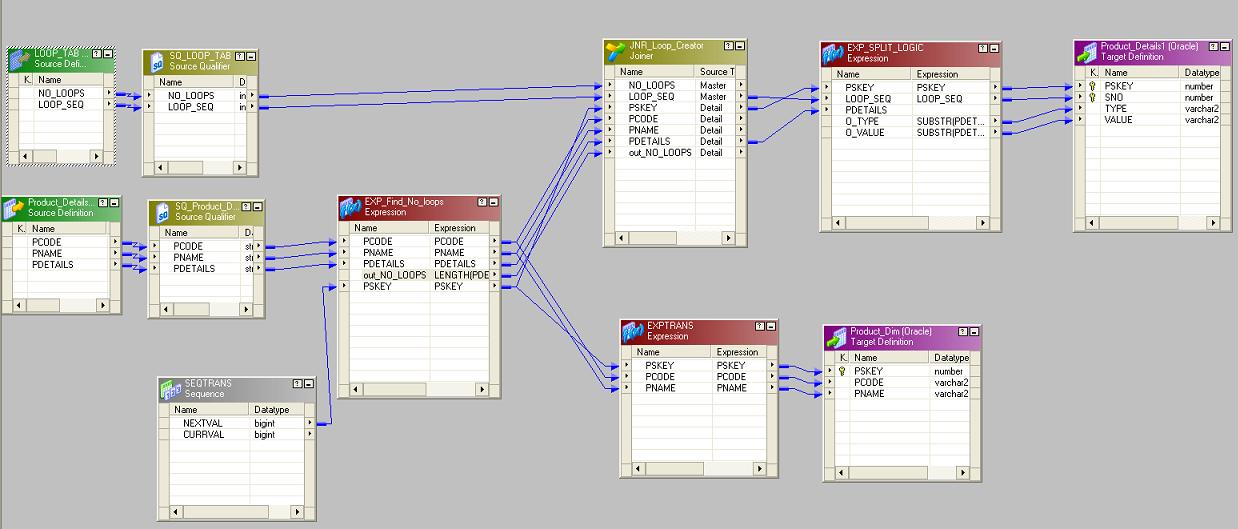Loops in Informatica
The simplest way to implement Loops in Informatica is explained below.
Source Name: Product_Details
Sample Input:
Pcode | Pname | Pdetails |
Water12 | Himalaya Water | Price,1.20;Qty,250ml;Brand,Himalaya;Class,Liquid |
Snack23 | Mad Pringles | Price,0.65;Qty,165 g;Brand,Mad Ltd;Class,Snacks;Batch,12312334;Exp,12/Feb/2012 |
note: in the pdetails column each product attribute separated with semi colon “;”
Targets: Product_Dim, Product_Details
Expected Output:
Product_Dim
Pskey | Pcode | Pname |
P1 | Water12 | Himalaya Water |
P2 | Snack23 | Mad Pringles |
Product_Details
Pskey | Sno | Type | Value |
P1 | 1 | Price | 1.20 |
P1 | 2 | Qty | 250ml |
P1 | 3 | Brand | Himalaya |
P1 | 4 | Class | Liquid |
P2 | 1 | Price | 0.65 |
P2 | 2 | Qty | 165 g |
P2 | 3 | Brand | Mad Ltd |
P2 | 4 | Class | Snacks |
P2 | 5 | Batch | 12312334 |
P2 | 6 | Exp | 12/feb/2012 |
If you closely observe the above Source and Target sample data, we need to have some kind of loop logic to extract the “Product_Details” from Pdetails column. Assume that each product has a different set of attribute values which can’t be predicted I.e. the number of attributes for each product varies.
Informatica Mapping:
Step1: Create a new table or a Flat file with the below structure and values
Tablename : Loop_Tab
| You can create this table using a simple PL/SQL script or VB script, in my example I created a table using below script. CREATE TABLE LOOP_TAB ( NO_LOOPS NUMBER(3), LOOP_SEQ NUMBER(3) ); BEGIN FOR I IN 1..100 LOOP FOR J IN 1 .. I LOOP INSERT INTO LOOP_TAB VALUES (I,J); END LOOP; END LOOP; COMMIT; END; |
Step2: Create a mapping as shown in below picture
- Pull the “Product_Details, LOOP_TAB” sources to mapping designer.
- Create a “Sequence Generator” transformation as show in picture.
- Create a Expression Transformation and pull all ports from SQ_ Product_Details and also pull the NEXTVAL from SEQTRANS.
Now add a new output port in Expression and name it as “out_NO_LOOPS” also change the data type to Integer, Now write the below expression in that output port “LENGTH(PDETAILS)-LENGTH(REPLACECHR(1,PDETAILS,';','')) “.
Basically from the above expression we will get to know how many attributes exists from a product.
- Now take a Joiner Transformation and Pull “LOOP_TAB” ports as Master Table and All the ports from “Exp_Find_No_loops” as Detail ports and apply Normal Join on NO_LOOPS= out_NO_LOOPS .
- Now Pull the targets “PRODUCT_DIM, PRODUCT_DETAILS” to mapping designer and connect them as per above mapping picture.
- You are done , All the best … Srikanth Mullamuri
